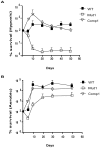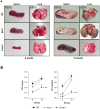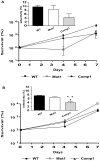Co-expression of DevR and DevR(N)-Aph proteins is associated with hypoxic adaptation defect and virulence attenuation of Mycobacterium tuberculosis
- PMID: 20195478
- PMCID: PMC2829086
- DOI: 10.1371/journal.pone.0009448
Co-expression of DevR and DevR(N)-Aph proteins is associated with hypoxic adaptation defect and virulence attenuation of Mycobacterium tuberculosis
Abstract
Background: The DevR response regulator is implicated in both hypoxic adaptation and virulence of Mycobacterium tuberculosis (M. tb). DevR regulon genes are powerfully induced in vivo implicating them in bacterial adaptation to host control strategies. A better understanding of DevR function will illumine the way for new strategies to control and treat tuberculosis.
Methodology/principal findings: Towards this objective, we used a combination of genetic, microbiological, biochemical, cell biological tools and a guinea pig virulence assay to compare the hypoxic adaptation and virulence properties of two novel M. tb strains, namely, a devR disruption mutant, Mut1, that expresses C-terminal truncated N-terminal domain of DevR (DevR(NTD)) as a fusion protein with AphI (DevR(N)-Kan), and its complemented strain, Comp1, that expresses intact DevR along with DevR(N)-Kan. Comp1 bacteria exhibit a defect in DevR-mediated phosphosignalling, hypoxic induction of HspX and also hypoxic survival. In addition, we find that Comp1 is attenuated in virulence in guinea pigs and shows decreased infectivity of THP-1 cells. While Mut1 bacilli are also defective in hypoxic adaptation and early growth in spleen, they exhibit an overall virulence comparable to that of wild-type bacteria.
Conclusions/significance: The hypoxic defect of Comp1 is associated to a defect in DevR expression level. The demonstrated repression of DevR function by DevR(N)-Kan suggests that such a knockdown approach could be useful for evaluating the activity of DevRS and other two-component signaling pathways. Further investigation is necessary to elucidate the mechanism underlying Comp1 attenuation.
Conflict of interest statement
Figures






References
-
- Cole ST, Barrell BG. Analysis of the genome of Mycobacterium tuberculosis H37Rv. Novartis Found Symp. 1998;217:160–172; discussion 172–167. - PubMed
-
- Tyagi JS, Sharma D. Signal transduction systems of mycobacteria with special reference to M. tuberculosis. Curr Sci. 2004;86:93–102.
-
- Av-Gay Y, Deretic V. Two-component systems, protein kinases and signal transduction in Mycobacterium tuberculosis. In: Cole ST, Eisenach KD, McMurray DN, Jacobs WR Jr, editors. Tuberculosis and the tubercle bacillus. Washington DC: ASM Press; 2005. pp. 359–367.
-
- Kinger AK, Tyagi JS. Identification and cloning of genes differentially expressed in the virulent strain of Mycobacterium tuberculosis. Gene. 1993;131:113–117. - PubMed
-
- Dasgupta N, Kapur V, Singh KK, Das TK, Sachdeva S, et al. Characterization of a two-component system, devR-devS, of Mycobacterium tuberculosis. Tuber Lung Dis. 2000;80:141–159. - PubMed
Publication types
MeSH terms
Substances
LinkOut - more resources
Full Text Sources

